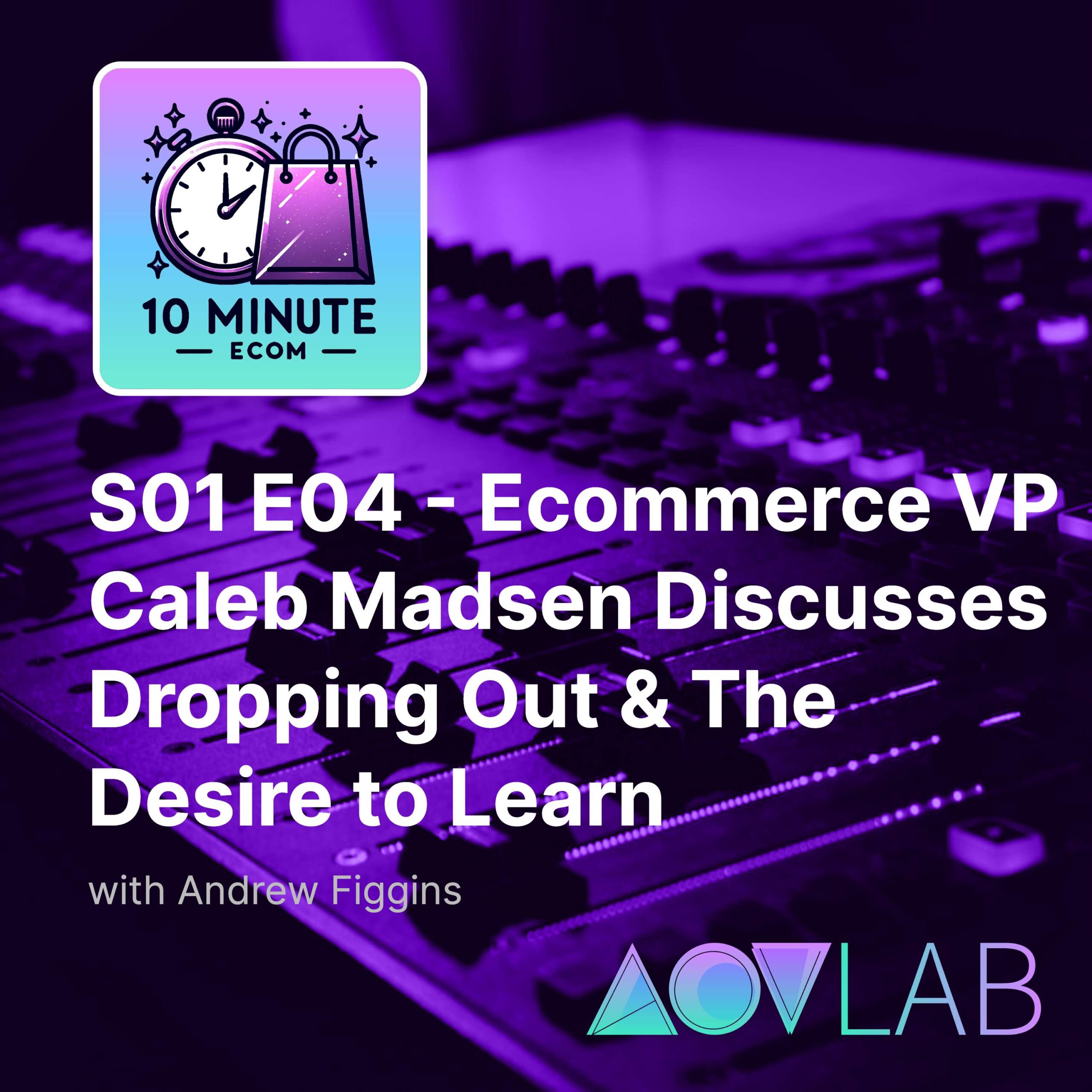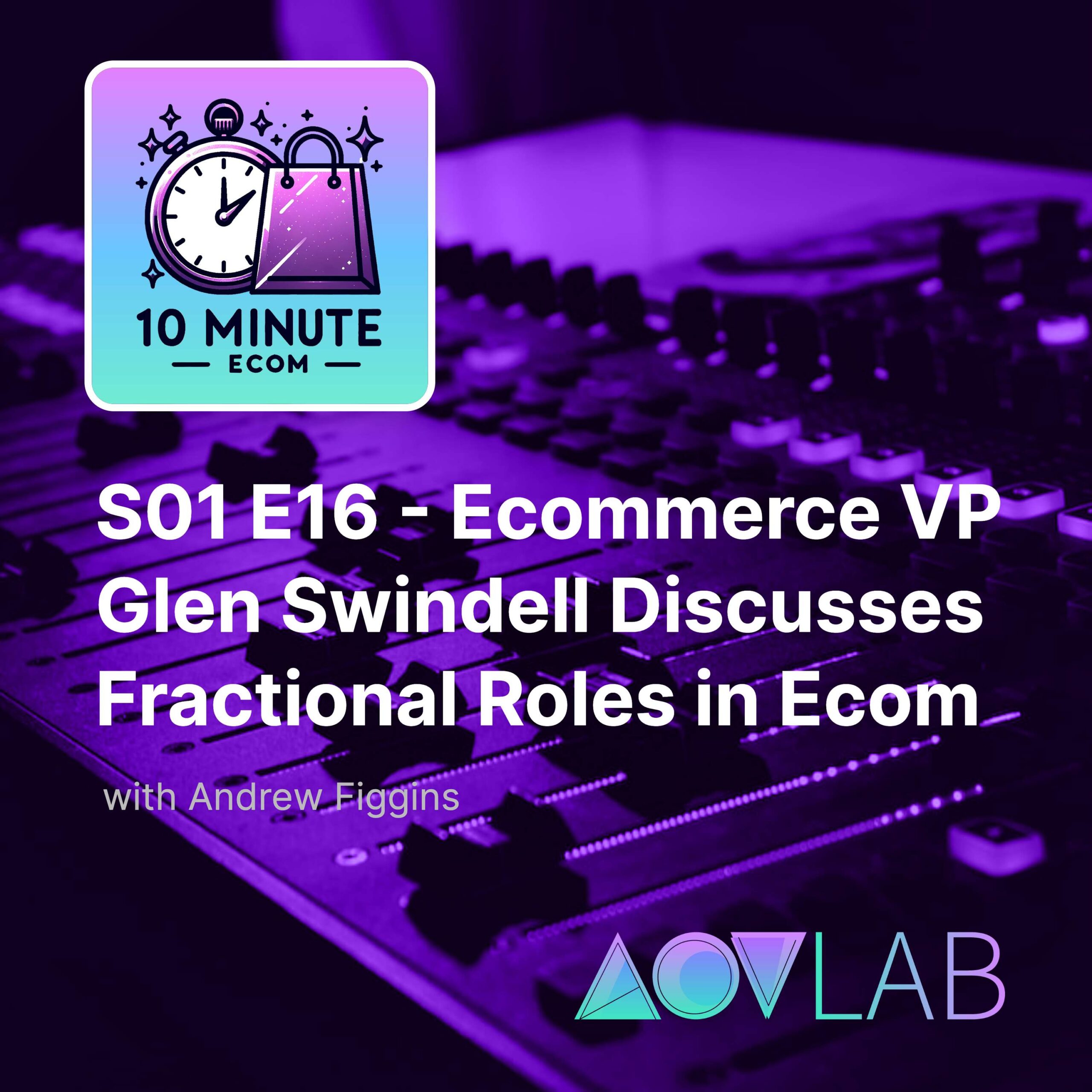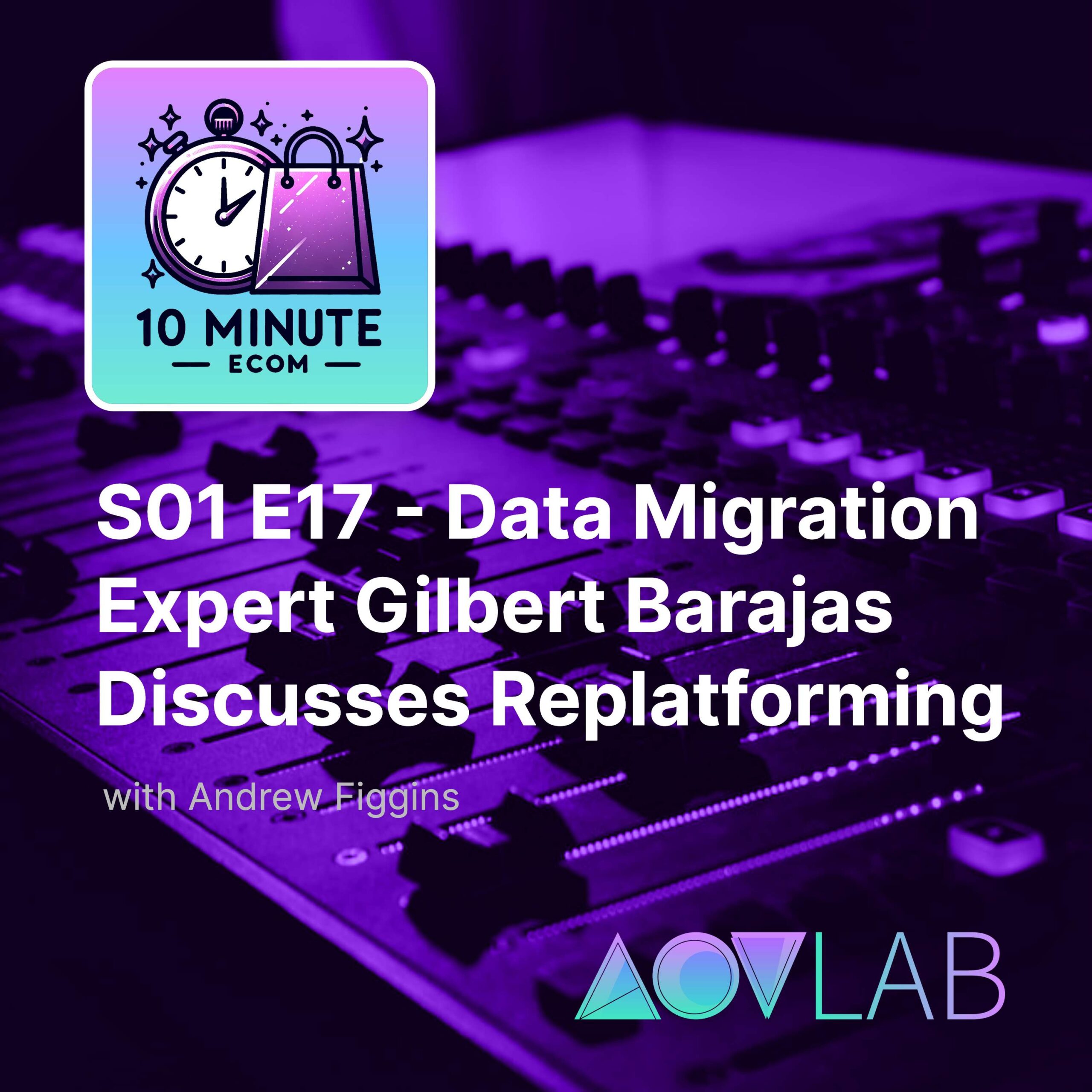[00:00:10] Speaker A: Hello Ecommerce fans, and welcome to Ten Minute Ecom, an AOV Lab podcast. Every episode we break down a new and different tactic that can help you improve your ecommerce KPIs key Performance indicators. I'm your host Andrew Figgins, and like most of you, I'm an ecommerce professional. You may know me as the former VP of digital product innovation at Scruz and beyond, or as the former director of e commerce technology at Rural King. Or just from LinkedIn. Today I'm excited to be talking to Jeremy Greider, an e commerce colleague that has held a variety of interesting roles in e commerce with Ecommerce vs. Hours and more. Jeremy, what did you come on the show to share today with your ecommerce colleagues?
[00:00:53] Speaker B: I'm Jeremy Greider and I work with e commerce companies to maximize their monetization and grow their businesses through e commerce.
One thing that I've seen that's worked really well in ecommerce is getting visual analytics around what you do online. In other words, using things like Lucky Orange or Hot Jar to actually see what is going on and react to how your customers are using the site. By doing this, I've seen results like going from 1.5 conversions to three and doubling it overnight. So that's a really good tactic.
[00:01:37] Speaker A: Thank you, Jeremy. And after the ad, we'll get right into the chat.
Today's episode of Ten minute Ecom is brought to you by Optiversal. Optiversal provides Aigenerated SEO landing pages that can help you rank and earn organic traffic for keywords you don't currently rank for. Their software is being used by some of the premier brands in Ecommerce, like Best Buy, Petco and Tractor Supply Co. I was Optiversal's customer at Scrubs and beyond and saw firsthand how Optiversal started from scratch and built a multimillion dollar organic traffic channel. Their technology 100% works. Go to Aovlab.com and click on Vendor Network to set up your 30 minutes discovery. Call with Optiversal. And now back to the show.
Tell me a little bit more. How do you get from 1.5% conversion to 3% conversion with being able to really represent what that customer's variance looks like?
[00:02:42] Speaker B: Basically the way I did it, and my first point of reference was doing it with Kettlebell. They decided that they would go with us to design their new site probably about 2014, maybe 2015. And basically they gave me a shot because I knew one of the owners. And what I did is I had them install Lucky orange. Hot Jar works very good as well. I just like the feature set on Lucky Orange but both give you heat maps and visual analytics. And so the great thing that we did for two months basically is Lucky Orange will basically record every session that comes through. It will also heat map everything so you can see analytics around where people are clicking on the site. It really is as simple as making sure you view some of these, see those interactions, get the feeling for what's going on. I think a lot of times with analytics we don't have the feeling of the emotion of the human side of it, right? It's all data, data and data is good, but having visual data is even better because as you look down the page on a heat map, you'll notice certain things that tend to have better play. People click on it more as they go down the site. So when you get something that's at the bottom and you're having a ton of people hitting it, move it up, move it up and if it gets more reaction, move it up a little further on the page, move that element up. And what you'll notice, and that's literally what we did with Kettlebell Kings. And what you'll notice is you get more interaction with the things that you want them to interact with. And look, here's the thing I always tell people when you first start out don't go out there and spend 30,000 to 100,000 on a site that's stupid. Go out there and create a site to the best of your abilities, either using a template and modifying it to fit your needs or doing a simplified version of what you're wanting to do. And by doing that, what happens is it gives you a chance to gather data on your clients. So basically with something like Lucky Orange you can look for a month or two, see how they're reacting and then modify it to that. That will turn into conversions which is what people should really care about, not just they think people are going to like. That is the stupidest thing that you can do in ecommerce is just think something and have no data behind it. That's very cool.
[00:05:25] Speaker A: So with the visual analytics, it sounds like one of the keys there is the heat mapping so that you could really test out that customer's journey. Did you find out that did customers surprise you with what they were doing maybe on mobile devices versus desktop? Or how did you sort of look at the breakdown between mobile versus desktop?
[00:05:44] Speaker B: Did you put your time more on mobile back then? Mobile wasn't yet as prominent as it is today, but yes, absolutely. I really like the concept of using some sort of a video image at the top that is more of a lifestyle about your brand, right? If that fits. And then basically having directional content as you go down if you do that sort of thing. Like, for instance, under the video or the Hero video or image if you go right under it and you have directional categories and things like that, doing those sort of things and just creating it as you go down and then watching Lucky Orange or Hot Jar to see how people interact with it. And then you're just basically taking sections and moving them to the place that people look at. And it is different on mobile. One of the biggest things on mobile is you get there and you scroll, scroll with that thumb action right there. It's definitely different.
You certainly have to look at both of those things and say, okay, it's a different device. And so they operate it differently and you have to approach it differently. But the concept works basically on both.
[00:07:00] Speaker A: Got you.
Because I think you've worked with some brands that obviously have some big sales and you've helped them generate those sales. You've started with some companies before that are just getting started in Ecommerce as well. Is there sort of a threshold of sales or success that a company has to get to before they implement some kind of visual analytics or are you.
[00:07:24] Speaker B: Saying to get no, not at all. Do it from day one, do it from day one because it will give you historical data to the point of start. Right. And when you're talking about lucky orange, it's very inexpensive. I think their basic plan and don't quote me on this obviously, because I'm not looking at it, but I believe their basic plan may be like $20 to $30.
So if you can't spend $20 to $30 to make sure you get better analytics, you probably shouldn't even start it because if you're one of these people that's constantly clutching the first on little things, you're not going to make it in ecommerce.
[00:08:07] Speaker A: Absolutely. Yeah, that's a tough pill for some to swallow, is you really have to spend some money sometimes to make some money, but $30 a month isn't big money and it sounds like you can get a big result from that, which is being able to map out those user journeys. Jeremy, it's been a pleasure meeting you, talking to you today. This is Ten Minute Ecom and so this is a quick show. Our ten minutes are basically up, but thanks so much again for coming on and sharing your expertise. Absolutely. Is there anything you'd love to just leave an audience of ecommerce professionals and.
[00:08:42] Speaker B: Your colleagues with before you go? I would always say in ecommerce, if you've got work ethic and you're persistent right, and you have a good product, I mean, that's t two, you can find success if you keep working at it and you use the tools that are out there. Do not be afraid to ask questions, to discover and learn from others because honestly, you don't have to be a millionaire to start, but you need to be smart about how you do it. And I've seen brands come from nothing to a million in a year just from some basic coaching and understanding around ecommerce. So absolutely, that would be my one statement, is be willing to put in the work.
It is worth it in the long run. The good stuff is worth it.
[00:09:39] Speaker A: Absolutely. I think what I'm trying to do is just create an additional place, an additional community where as many tactics as we can get together. And just like you said, for people just starting out or, I know, for myself, the last seven years, from time to time, I needed you in my ear, reminding me of hey, go back and look at those key maps. Like, go and put something in, like, lucky orange. And even on my new site that I launched a month ago, I don't have any visual analytics yet. So I'm like, damn, I got to listen to Jeremy. I got to go.
[00:10:11] Speaker B: Oh, dude, it's so good. Dude, I'm telling you, it's the way to go. Because everybody always looks at Google Analytics, but it has no heart. You don't see anything.
[00:10:19] Speaker A: Really well said, Jeremy, and thanks again for coming on today. Really appreciate your time.
[00:10:25] Speaker B: No problem. Thank you.
[00:10:27] Speaker A: Well, we have hit that ten minute mark, so that's a wrap for today's episode. I want to again thank our guest, Jeremy Griter. If you have a moment, be sure to subscribe or follow the show on Apple podcasts Spotify, Amazon Music, Google Podcasts or wherever it is that you listen. If you have a topic suggestion, or if you're an ecom professional that would like to join for an upcoming episode, reach out to
[email protected] and a human will read and respond to your inquiry. I will just come out and admit that I am the human. Anyway, I hope you're digging these first episodes of the show. It's been a real joy to talk to the first few guests and interview them. Until next time, this is Andrew Figgan signing off for today and saying, have a good one.
Our.


